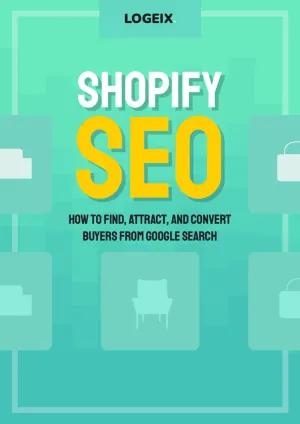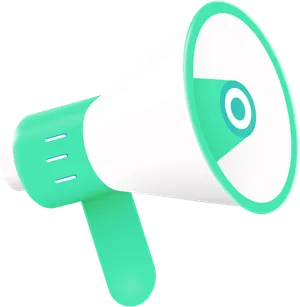eCommerce SEO: 22 Mistakes from Auditing 1,200 Stores

Using a mixture of manual research and a simple custom-built scraper, I’ve spent the last month auditing 1,200 sites to give you a data-backed analysis of the biggest SEO mistakes.
Before we dive into those mistakes, you’ll need to understand what we’ll call the three key page-types:
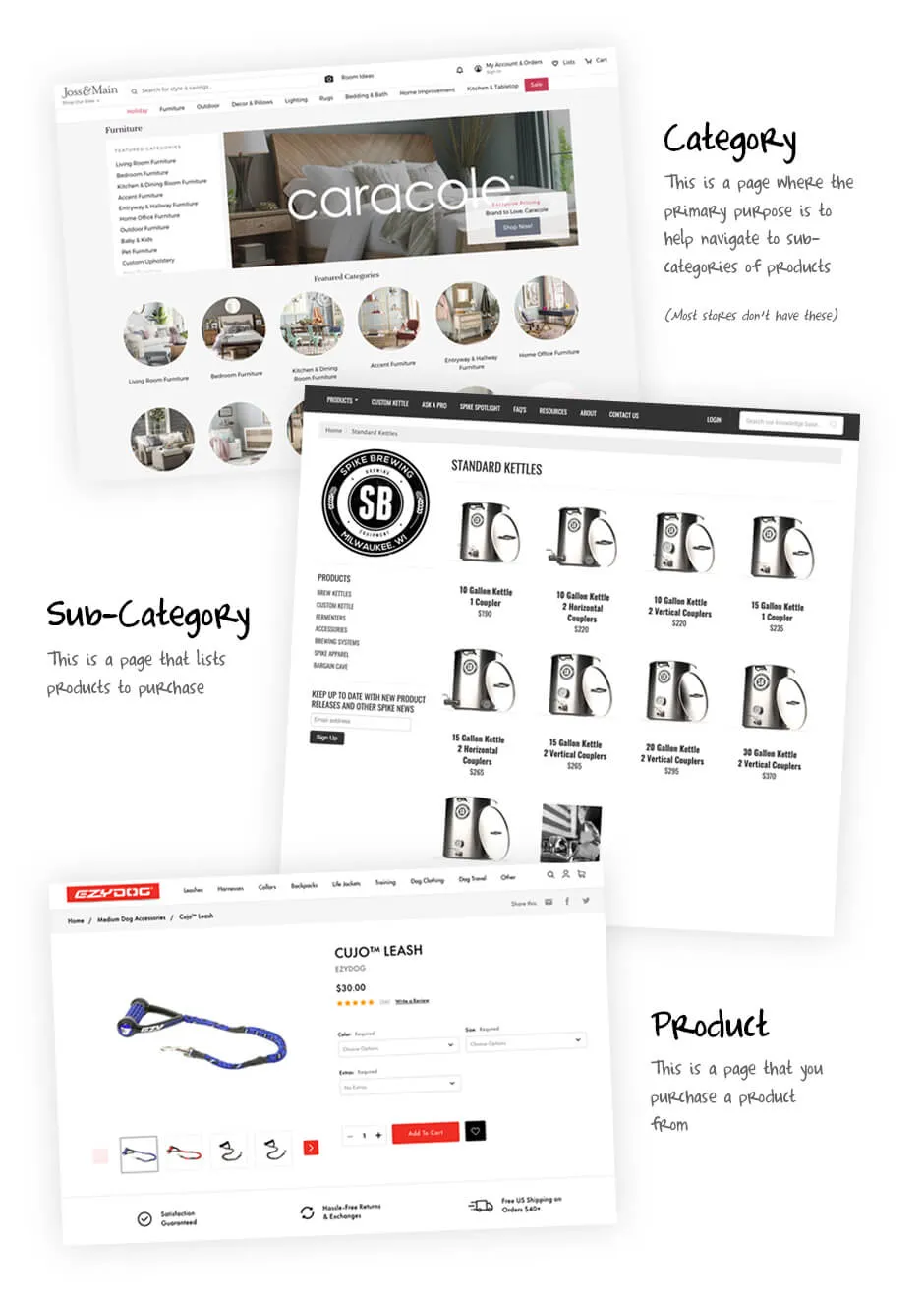
These are usually the main pages to rank because of the high buyer intent i.e. someone searching for ""buy sofas online"" (category or subcategory page) is more likely looking to make a purchase now than someone searching ""small room sofa ideas"".
This also simplified our research, as we didn’t have to review every page on all 1200 sites, which could result in tens of thousands of pages on a single store, in some cases.
With that said, let’s dive into the mistakes…
Title Tag
The title tag is an SEO basic and essential, which is usually set automatically by virtually every eCommerce platform. Hence why, only 2 websites out of 1,200 had none set at all.
Yet, out of the 1,198 that were using them - only 107 had fully optimised them across the three page types we checked.
There’s two types of under-optimisation here and one type of over-optimisation, which we’ll cover in the mistakes.
First, let me explain what a title tag is for beginners:

The title tag in this case is ""Buy Chanelle Leather Sofa Online in London, UK | Denelli Italia""
A title tag is (…you guessed it) the title of the page, which will be shown within search engines. It’s one of the more important onsite factors, and should be optimised for keywords you’d like to rank for.
I’ll explain how in the following two title tag mistakes…
Mistake #1: Not Using Modifiers
eCommerce sites usually consist of too many pages to manually optimise every single one, instead you use templates to optimise pages fast.
A default template for a product page may be:
[Product name] - [Shop Name]
Which for a website named ""Lion Zeal"" selling an Audio Technica ATR2500 microphone, would be:
Audio Technica ATR2500 - Lion Zeal
Keyword modifiers are words we add to this template to extend the keywords we’re optimising to rank for. In short, we need to use words to have any chance of ranking for them.
In online shops case, these will usually be words like:
- Buy
- Online
- Cheap
- Discount
- Sale
Putting this together, our example title tag (following a template) may look like:
Buy Audio Technica ATR2500 Microphone Online - Lion Zeal
We’ve added the modifiers ""buy"", ""microphone"", and ""online"" in this case to increase the number of keywords we’re optimised for, such as:
- Buy Audio Technica ATR2500
- Buy Audio Technica ATR2500 microphone
- Buy Audio Technica ATR2500 online
In the above example, this template would be valid for all product pages selling microphones.
This same principle can (and should) be applied to category and subcategory pages.
Our research showed only 107 out of 1200 sites (8.92%) were using modifiers in their title tags on all 3 page types. And a little bit higher (162) if looking at the product pages only, which adds up to 13.5%.
This is a tiny minority of sites for something so simple, yet beneficial to your traffic. It is extremely simple to rank for ""buy Audio Technica ATR2500"" compared to ""USB microphones"".
Mistake #2: Keyword Stuffing
On the opposite side of missing keyword modifiers is optimising too much. Suitably named ""keyword stuffing"", it’s where webmasters deliberately write as many keywords as they can in an attempt to gain SEO benefits.
An example from our study:
Cheap Beds & Bed Frames | Buy Affordable Beds Online | Time4Sleep
In the above example, if we count the singular and plural of ""bed"" as one word, this title uses it 3 times - which is overkill.
They’d be better with:
Buy Cheap Beds & Frames Online | Time4Sleep
Here’s what we’ve changed and why:
- We’ve removed ""affordable"" as it’s a synonym for ""cheap"" therefore not needed
- We’ve changed it from ""Bed Frames"" to ""Frames"", as the page and title is already on the topic of beds
- Finally, we’ve shortened it into one simple title which leaves extra space for a call-to-action e.g. ""Free Delivery""
There’s a difference between using modifiers to better explain the page while expanding the keywords, and overdoing it i.e. keyword stuffing.
Here’s signs you’re on the over-optimisation side:
- You’re using multiple keywords separated by a | character
- You’re repeating words unnecessarily (in the above example, most sites write ""Beds & Bed Frames"", so it’s probably fine)
Our research showed this was much less common with only 202 out of 1,200 sites repeating keywords in the title tag (16.84%), but still worth noting when advising on the importance of optimisation.
Meta Description
Below the title tag, you’ll find the meta description, which as the name makes clear, gives a description of the page.
Here’s how it’ll look in the SERPs:

The description here is the 3 lines of small text (non-blurred) that looks to be a selection of random (but keyword relevant) sentences on the page. In this example, it’s not enticing to click whatsoever.
This is another fundamental part of the onsite SEO process, and very easily fixed.
Mistake #3: Not Optimising
The most common mistake here, like the example above, is not optimising the meta description at all.
Of the sites we analysed, 244 of them (20.34%) had blank or non-set meta descriptions on one of their 3 pages in the study.
9.25% (111 sites) were using an identical one on across least two pages.
And 7 of 1,200 (0.58%) had descriptions of more than 158 characters set, which is likely too long to be shown.
If we use the above three issues as our benchmarks of a bad meta description, after removing sites with multiple issues, 291 had issues. That adds up to 75.75% being correctly optimised - ignoring CTR, as mentioned below.
When your meta description is setup incorrectly, a random sample of text that’s most relevant will be shown, as clear in the example further above.
Or your page/product description will be automatically used by your store platform, which isn’t optimised for clicks or keywords, and may be invalid (multiple sites were inserting HTML in their meta description).
Similar to title tags, the solution for this is templates.
Here’s an example meta description from our research:
Buy Matcha green tea powder online from Kanuka Tea. Top Ceremonial Grade. Free UK delivery. Buy now!
Presumably, they’re doing this with a template for all their tea’s. In this case, the template would be set to:
Buy [Product Name] online from [Store Name]. Top Ceremonial Grade. Free UK delivery. Buy now!
Though, if your title tag is already set to ""Buy [Product Name] Online"", then you may want to use a different template to mix this up. Such as:
Shop for 100% Organic [Product Name]. Top Ceremonial Grade. Free UK delivery. Buy now!
The meta description here should include a few additional words you may want to rank for, in this case, presuming the product is Matcha Green Tea Powder:
- Matcha green tea powder shop
- Organic Matcha Green Tea Powder
- Ceremonial Grade Matcha Green Tea Powder
- And other similar variations
More importantly though, and this ties in with the next mistake, it needs to generate clicks.
Mistake #4: Not Optimising for CTR
Aside from keyword relevance, which is a necessity, the most important factor of the meta description is that it’s optimised for clicks.
This is commonly referred to as clickthrough rate (CTR) optimisation, meaning making changes to increase the percentage of people that clickthrough to your website from search engines.
Only 286 sites in our study (23.84%), were optimising their meta descriptions for CTR across the 3 pages we checked (per site).
There’s a few common practices to achieve this:
- Include a call-to-action that urges readers to click e.g. Browse our collection of living room furniture sets online today!
- Capitalise the first letter of key words e.g. Free Next Day Delivery
- Include features/benefits of your products and service such as free nationwide shipping, next day delivery, guarantee’s, discounts, etc
Take this example for a toy store selling Batman LEGO on this subcategory page:
A1 Toys Store is an independent UK toy specialist. We stock anything from limited edition collectables and comic con exclusives to Minifigures. Featured brands include WWE, Power Rangers, Transformers, My Little Pony, Star Wars and many more!
Firstly, this isn’t optimised for Batman LEGO specifically. Secondly, it’s too fluffy with information and not captivating enough to encourage you to click.
Here’s what I’d write instead:
Buy the Official LEGO Batman Movie Sets. As seen in the box office movie. Free Nationwide Shipping. 14 Day Returns. 100% Secure.
These small changes lead directly to more traffic to your site, and indirectly, as CTR (clickthrough rate) is also a Google ranking factor.
Bonus Tip: Not Including Emojis
One simple trick to stand out further in the SERPS (search engine results page) is to include emojis in your title tag and/or meta description.

This is unlikely to directly increase your rankings, but it’ll certainly increase the clickthrough rate and therefore traffic. Which arguably may influence rankings.
Google can be a bit picky about these showing sometimes, but to add one is really simple, just paste in the emoji when setting your title tag or meta description.
Our data showed 6 out of 1,200 sites (0.5%) were using an emoji in their meta description, with all of them using simple ticks or arrows to draw attention to features/benefits.
Category Pages
The next category of problems occur on the category and subcategory pages.
These are key pages for SEO as they allow you to target keywords that you simply can’t on the product pages.
For example, if you’re selling computer accessories, you could rank for a product name (e.g. ""Buy Logitech MX Master 3"") on the product page. But what if you want to rank for ""Buy Logitech Mice Online""? Or ""Buy Gaming Mice Online""?
These are where your subcategory pages come, which allow you to filter your products to create content and pages for certain options.
Mistake #5: Not enough categories
One mistake many stores make is not using enough categories or subcategories. Now, I don’t have specific data to share for this, so you’ll have to take my word for it.
But here’s a couple surprisingly skipped over ideas of how you can increase the number of categories:
- Create one for each manufacturer e.g. on your computer accessories store, you could have one for Logitech, Razer, Microsoft, etc
- Create one for each room e.g. living room furniture, kitchen furniture, bedroom furniture, etc
Aside from that, you’ll want specific pages for any unique but highly searched type of product like gaming mice, in the above example.
Mistake #6: Not Writing Enough
Once the categories or subcategories are in place, you need a sufficient level of content on these pages to rank them.
Unfortunately, there’s no clear cut answer of how much content is the right amount of content. The typical SEO answer is ""slightly more than the average of your top competitors"".
Our study showed, the average number of words on category pages is 134.54, and for subcategories is 105.90.
The problem, however, is that 152 sites (37.35%) had no description on their category pages, and 501 sites (41.75%) had no description on their subcategory pages, aside from their product lists - which counts for very little.
(Note: Only 407 sites were using category pages by the definition we’ve followed in this article, where the primary purpose is to link to sub-categories)
The solution is, of course, write more quality content. Not filler content. But content that leads closer to the sale.
Remember: Your category or subcategory pages may be the first page they ever visit on your website, what will they need to know before they’ll be ready to make a purchase?
- How is your range of products selected, manufactured, etc?
- Why should they buy your products or from your website?
- How do these products work? For example, if you’re selling custom printed advertising banners, you should explain the steps and how it’ll work
- Delivery times
- Why your pricing is lower or higher
- And anything else someone would ask or question before purchasing this category of products
Be careful with placement though, you don’t want to get in the way of browsing products.
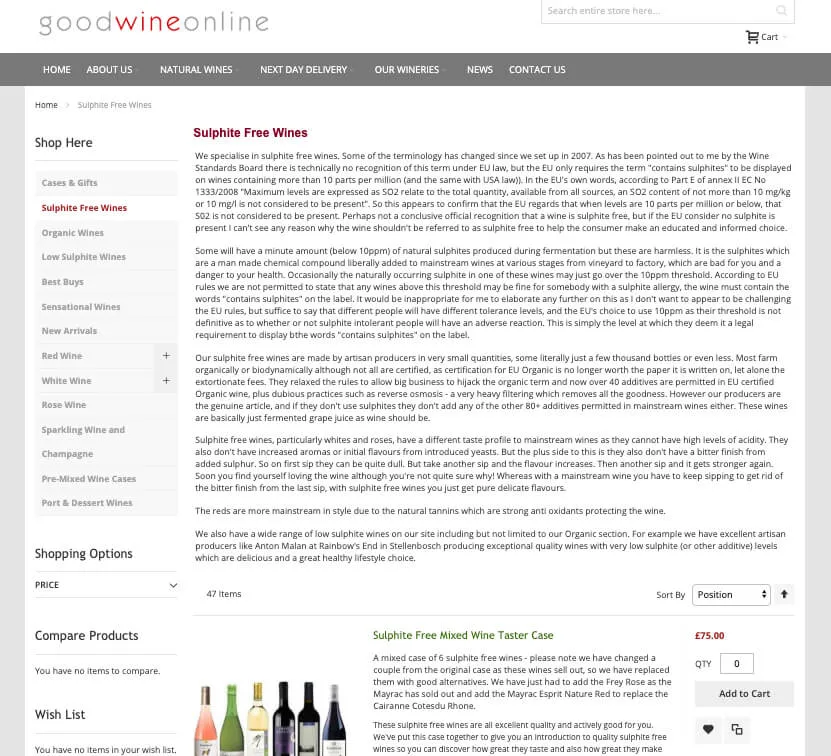
Don’t overwhelm your visitors with a wall of text, break it up with media, and have your products as the main focus on the page. In this example, you may even have to scroll the page (multiple times on mobile) before you can see their wine selection.
Generally, you’ll show the essential information above the products - this will usually be short. And the rest will be either below the products/subcategories list or below the essentials with a ""Read More"" link to expand it.
Mistake #7: Spammy Tactics and Low Quality Content
On the opposite spectrum of not having enough content is having too much, usually extremely low quality with spammy tactics to mask it.
Now, I’m addressing this as a mistake because I think it is. However, I’ll be honest, I doubt the websites utilising these tactics are having issues. It’s just not a great long-term strategy.
Here’s what I’m referring to:
Content that is useless and boring to your potential customers, added to the page solely for SEO benefits, then hidden with techniques like:
- Extremely small fonts
- Multiple ""Read More"" links which expand the content. One is normal, multiple is excessive
- No use of images, videos, or any type of media to make the content more interesting - just huge chunks of text inserted at the bottom of the page or under a read more link
Again, that doesn’t mean these tactics don’t work, it’s just not as great a user experience, and not thinking long-term.
If your content isn’t intended to be read by an actual potential customer, it probably shouldn’t be on the page. For example:

If your content is good, would you really make someone click twice to see it?
As for how to create great content, treat your page as a potential buyers first impression of your business, what do they need to know? As explained in the previous mistake.
Product Pages
The final type of page we focused on in our research is product pages, the pages that list a single product for sale.
In most businesses, there’s going to be benefits from ranking these pages for the product name or ""buy [product name]"" keywords, even if the volume of searches for these are low.
Unfortunately as clear in the title tag/meta description research, only 8.92% of sites had both fully optimised on the product page we analysed.
Further than that, there were four key mistakes that stood out:
Mistake #8: Short (or Non-Existent) Descriptions
As explained above, without content, you can’t expect to rank in Google. However, many stores have as little as a sentence, or worse nothing, written for their product descriptions.
The average length in our research was 68.94 words, yet 352 sites (29.34%) had zero description, and 657 sites (54.75%) had less than 50 words.
All of this makes sense when you consider some stores list hundreds or thousands of products, but that’s like avoiding training your sales team about your products because you have too many.
From both an SEO and sales/conversion standpoint, content is not optional on your product pages. Therefore the real problem becomes, how do you create amazing content for a single product?

A typical Amazon listing will have a long, detailed title along with hundreds of words describing the product. This example has 291 words in the bullet points alone, plus an extended description further down the page.
Here’s a few ideas:
- Have bullet points for each feature, followed by a benefit explanation e.g. interchangeable caps is a feature, but what benefits does having these two cap options provide?
- Share different use cases of your products (if applicable)
- Share your opinion and review of a product if it’s a generic product they can buy anywhere
- Overcome objections people may have before purchasing (live chat is great for establishing these)
Ideally, each product should have hundreds of words (or more) helping to close the deal. Not only from a traffic perspective, but in order to convert your visitors into buyers.
If this is their first time visiting your website, having a sentence (or worse, nothing) is unlikely to convert them into a buyer.
Mistake #9: Copied Product Descriptions
Worse than a short description is a copied one. It may seem logical to cover the manufacturers product description, but there’s two reasons why this is a horrible idea:
- It’s rarely written in a way that will convert your visitors
- It’s classed as ""duplicate content"" from an SEO perspective, so you’ll be trying to rank the exact same content as hundreds or thousands of other eCommerce stores
That doesn’t mean you can’t use parts of it, for example, specifications (i.e. size, weight, material, etc) will always be the same, so feel free to copy them.
But you should also have a custom written product description.
Mistake #10: Missing Product Schema
For the next few mistakes, things will get more technical, starting with Schema.org Markup, specifically for products.
In short, this is a piece of code you can add to your webpage to explain the content to search engines. Sometimes, these details may be shown in the search results, giving a boost in CTR.

These results stand out much more in the Google Search Results with the star rating and other additional details shown on that row
Many eCommerce platforms will add this by default now, but our research still found 50.08% of sites did not have it.
If that’s the case for your store, we highly recommend adding it. It’s best practice, and can potentially lead to small ranking improvements.
More importantly, it can lead to massive clickthrough-rate improvements.
By default, there’s a few essential details you’ll want to explain with Schema.org tags/code:
- Product Name
- Description
- Image
- Price (and currency)
- Availability (is it in stock?)
- Reviews and aggregate rating
The magic comes from the elements shown in the screenshot shown further above:
- Aggregate Rating
- Total number of reviews
- Price
- Availability
If set, all of this information has a chance of being shown in the Google search results, which stands out therefore leading to a sizeable traffic increase.
Unfortunately, our data found only 20% of sites had an Aggregate Rating set, however, this could simply be down to not having any reviews on that specific product page.
The percentage of sites missing Product Schema (50.08%) is a more accurate measure here. Though, considering we picked top-of-category products for our study, it says something about the importance of asking your customers to leave reviews (and then showcasing these on your product pages).
Internal Linking
Internal links are where you link from one page to another on your website. You can do this from blog posts, linking to relevant products or categories mentioned.
But there’s also a standard link architecture when building your site.
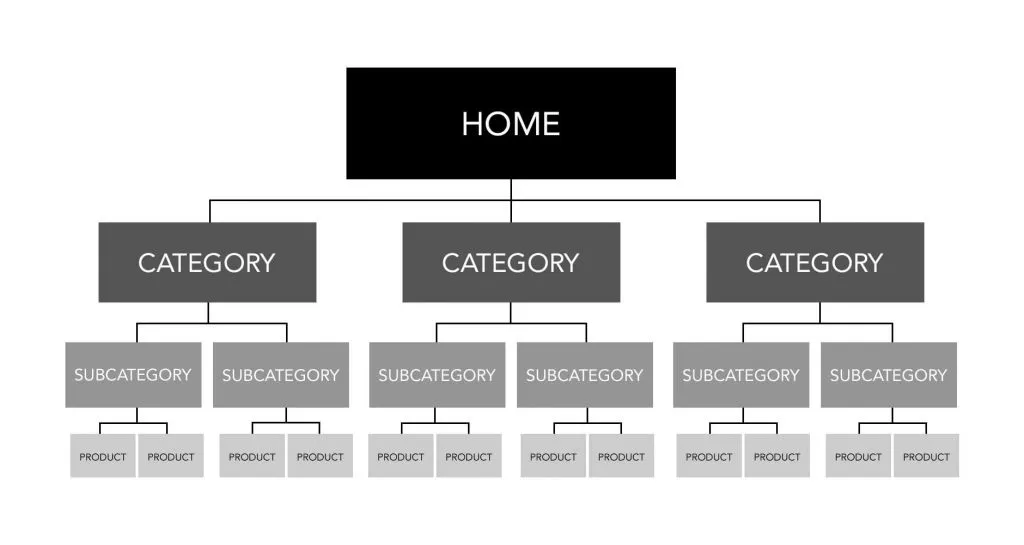
Most eCommerce stores follow an internal linking structure like this, where a category could be ""Living Room Furniture"" and subcategory could be ""Sofas"", as an example
This type of site architecture is perfect from an SEO perspective because of a few general rules that apply to most eCommerce sites:
- The homepage tends to be the strongest page on the website in terms of backlink authority (i.e. has the most links to it from other websites)
- As a result of this, the more clicks away from the homepage, the weaker a page will be
Within the structure above, product pages can be accessed within 3 clicks. You choose a category, subcategory, and then are presented with products.
(Usually you’ll prioritise best-selling products at the top, so this doesn’t necessarily mean users won’t apply filters or use pagination to click onto the next page of products)
This is also great for user experience - it’s fast and easy.
Mistake #11: Bad Site Architecture
The problem is when this becomes extended, and it suddenly becomes 6 clicks to find a product - even when you know what you’re looking for.
Take an office furniture website I looked at, the site architecture was like this:
Homepage > Office Chairs (Category) > Operator Chairs (Subcategory) > 1 Lever Operator Chairs (Subcategory) > Laval High Back Operator Chair (Product)
This final subcategory should instead be options on the page to narrow down the list, therefore reducing the number of clicks by one.
And that’s a simple problem, some sites had significantly worse structures than this.
For most sites, keep this simple and use the structure from the diagram above. If your store is smaller doesn’t have categories, then just skip that part of the structure.
Mistake #12: No Breadcrumbs
Another internal linking issue is a lack of breadcrumbs. Which, ironically, I’m not using on this website - by choice as the navigation is so simple.
For eCommerce sites though, I recommend adding them for user experience, and also because search engines tend to like them.

A breadcrumb is links at the top of the page content allowing you to look back at where you’ve came from, so you can quickly click back to the subcategory or category
These are relatively simple to setup, usually coming default in eCommerce themes. However, there were still 228 sites (19%) not using them in our research.
Site Speed
Another factors that matters equally from an SEO and conversion standpoint is site speed.
A study by Google found the following impact of site loading times on mobile visitors:
- 1-3s loading time increased the bounce rate by 32%
- 1-5s loading time increased the bounce rate by 90%
- 1-6s loading time increased the bounce rate by 106%
- 1-10s loading time increased the bounce rate by 123%
For those unsure, bounce rate is a measurement of the percentage of people that leave a website without browsing more than one page.
Mistake #13: Slow Loading Times
Put simply, the slower your website loads, the less traffic will stay on your website, therefore the lower your sales conversion rate.
From an SEO perspective, the influence of site speed is a commonly debated topic across the industry.
The general consensus is that being lightning fast may not necessarily increase rankings, but having a slow or inconsistent loading website will most definitely damage them.
Aside from real world experience making that clear, it’s also obvious from Google’s perspective. If slow loading sites rank high, people are less happy with the results, therefore less happy with Google.
Our data showed a 3.97 second average loading time according to Google Page Insights.
Is this normal? Well, in a video from the Google Webmaster Team when asked what a ""good responsive time"" to aim for, they said:
Studies by Akamai claim 2 seconds as the threshold for ecommerce site ""acceptability."" Just as an FYI, at Google we aim for under a half-second.
That doesn’t necessarily mean your site needs to be faster than 2 seconds, but it is at least clear that you should aim to have a fast loading site, from both an SEO and conversion point of view.
In our research:
- 72.67% of sites had slower average loading times than 2 seconds
- 55.08% of sites had slower average loading times than 3 seconds
- 22.98% of sites had slower average loading times than 5 seconds
The question then becomes, how do you decrease your site loading time? To answer that, I’ll share a few tips:
1. Use a faster DNS host
Most domain registrars and web-hosts will offer to manage your DNS for you. This is where your nameservers will point (e.g. dns1.registrar-servers.com dns2.registrar-servers.com are the default for NameCheap).
Without getting too technical, the important thing is that every provider has a different level of speed.
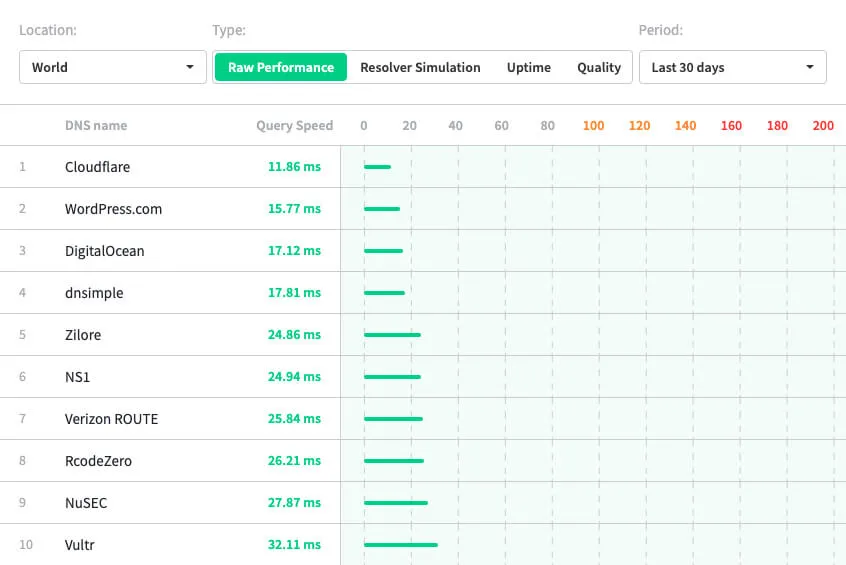
The top 10 fastest DNS providers according to DNSPerf
By moving to a faster DNS provider like CloudFlare, in some cases, you can speed up your site by upwards of 100ms with very little effort.
2. Use a CDN
A content-delivery network (CDN) is a service that stores copies of irregularly changed files and media (known as Static Content) so they can be loaded quicker, without having to check if there’s been changes every time someone loads the page.
Even better, this Static content will usually be stored on servers closer to the visitors location, so it loads even faster.
(For non-technical readers, if you’re in the UK but visiting a website hosted in the Australia, this will load slower than a website hosted in the UK)
There’s several CDN providers available including CloudFlare, Incapsula, MaxCDN, Amazon CloudFront, and many others.
3. Compress Large Images
If you’re using a decent camera to take photos (you should be), even modern day smartphones, the resolution and file size is likely to be several megabytes.
In other words, these images will take a long time to load, especially on sites with several images (which is bes
